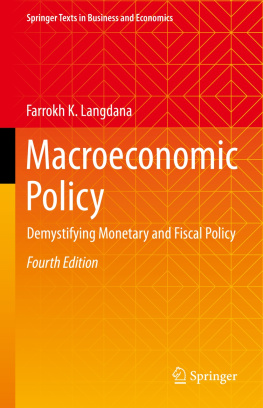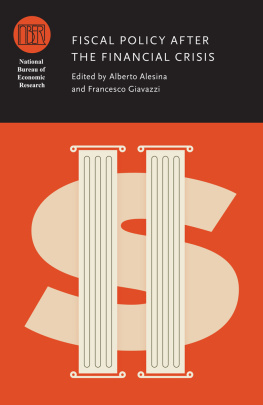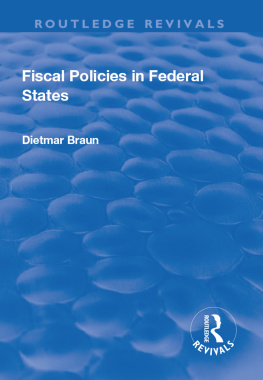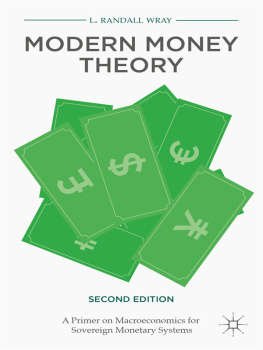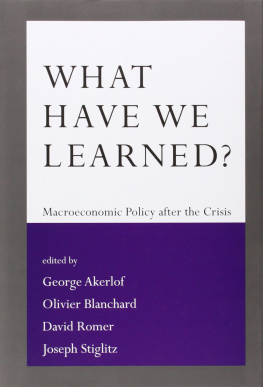Farrokh K. Langdana - Macroeconomic Policy : Demystifying Monetary and Fiscal Policy
Here you can read online Farrokh K. Langdana - Macroeconomic Policy : Demystifying Monetary and Fiscal Policy full text of the book (entire story) in english for free. Download pdf and epub, get meaning, cover and reviews about this ebook. publisher: Springer International Publishing, genre: Politics. Description of the work, (preface) as well as reviews are available. Best literature library LitArk.com created for fans of good reading and offers a wide selection of genres:
Romance novel
Science fiction
Adventure
Detective
Science
History
Home and family
Prose
Art
Politics
Computer
Non-fiction
Religion
Business
Children
Humor
Choose a favorite category and find really read worthwhile books. Enjoy immersion in the world of imagination, feel the emotions of the characters or learn something new for yourself, make an fascinating discovery.
- Book:Macroeconomic Policy : Demystifying Monetary and Fiscal Policy
- Author:
- Publisher:Springer International Publishing
- Genre:
- Rating:4 / 5
- Favourites:Add to favourites
- Your mark:
- 80
- 1
- 2
- 3
- 4
- 5
Macroeconomic Policy : Demystifying Monetary and Fiscal Policy: summary, description and annotation
We offer to read an annotation, description, summary or preface (depends on what the author of the book "Macroeconomic Policy : Demystifying Monetary and Fiscal Policy" wrote himself). If you haven't found the necessary information about the book — write in the comments, we will try to find it.
Macroeconomic Policy : Demystifying Monetary and Fiscal Policy — read online for free the complete book (whole text) full work
Below is the text of the book, divided by pages. System saving the place of the last page read, allows you to conveniently read the book "Macroeconomic Policy : Demystifying Monetary and Fiscal Policy" online for free, without having to search again every time where you left off. Put a bookmark, and you can go to the page where you finished reading at any time.
Font size:
Interval:
Bookmark:

Springer Texts in Business and Economics (STBE) delivers high-quality instructional content for undergraduates and graduates in all areas of Business/Management Science and Economics. The series is comprised of self-contained books with a broad and comprehensive coverage that are suitable for class as well as for individual self-study. All texts are authored by established experts in their fields and offer a solid methodological background, often accompanied by problems and exercises.
More information about this series at https://link.springer.com/bookseries/10099

This Springer imprint is published by the registered company Springer Nature Switzerland AG
The registered company address is: Gewerbestrasse 11, 6330 Cham, Switzerland
To my wife,
Mary
Macroeconomic policy analysis has been in a state of flux since the early 1970s. Although the casual student of macroeconomics might expect that economists would have come to some agreement in our quest to model the so-called real world, the analysis of macroeconomic policy has perhaps never been so confounding as it is today. Each monetary or fiscal policy event is almost inevitably followed by at least two completely different and conflicting sets of analyses.
Consider, for example, the question of whether government spending affects GDP growth. One can find just about any answer to this question possiblesome say it increases GDP, some that it decreases GDP, and some claim no effect. Others go on to claim that the answer depends on whether the economy is a developed one, such as the USA, or an emerging one, like China and India.
Another central source of confusion is the proverbial Phillips Curve, which, as originally conceived, related the unemployment rate to wage inflation. Some researchers have found an inverse relationship between these variables; others have found no link at all. Whats more, the economics profession has introduced new and improved variants on Phillips tradeoff themeinflation versus unemployment rates, inflation versus GDP growth, inflation versus capacity utilization, and so on. For each of these postulated relationships, virtually any conclusion can be found. And to confound things further, the conclusions appear to change as the economy changes. The statistical evidence from the much-heralded New Economy of the late 1990s seems to suggest that rapid GDP is linked more to low than high inflation. Will the real Phillips curve relationship please stand up?
Conceivably, there are as many interpretations of economic phenomenon as there are economists to interpret them. All this may be well and good from the standpoint of the passionate researcher, who makes a living in an endless search for the macroeconomic Holy Grail. But for the typical student, less interested in contrast and more interested in conclusions, the result can be a state of confusion as he or she moves from class to class, from book to book, or from publication to publication. Finding the truth for economics students has become a bit of a mystery.
Enter Farrokh Langdanas book, aptly titled Macroeconomic Policy: Demystifying Monetary and Fiscal Policy. Not only does the book shine a bright light through the dense fog surrounding economists centrist position on macroeconomic thought, it does so with a set of tools virtually all readers can handle. The cumbersome mathematics that most modern economists love but most students loathe are put aside in favor of teaching tools with wider appeal and suitability.
Even economists have recognized that as our profession has aged, our languageboth verbal and quantitativehas become more convenient and precise for us, but less accessible and attractive to the general audience. So, what should the economics professor do? Economist Francis Edgeworth, writing nearly a century ago about Alfred Marshall, one of economics original and first-class mathematicians, said that Marshall, who desired above all things to be useful, deferred to the prejudices of those that he wished to persuade (emphasis added). In other words, we should speak in the language of our audience, not our profession. Increasingly, the economics profession shuns this communication principle in favor of rigor, all the while knowing that, as economist Robert Heilbroner said, Mathematics has given economics rigor, but alas, also mortis.
The Bureau of Labor Statistics estimates that there are roughly 19,000 economists (including economics professors) in the USA out of a population of roughly 331 million. This figures out to be about one economist for every 17,500 people. Must not it be important to speak to the other 17,499, not just to the one? Of course, and thus this book is written for you, not for economists.
When Richard Alm and I wrote Myths of Rich and Poor, we set out to debunk a series of widely accepted myths that the USA was lagging behind economically, and that its citizens were getting progressively worse off. We accomplished the complete dismantling of such myths by presenting systematic overwhelming evidence that the USA has been prospering splendidly in recent decades, and we did so using the only tool possible for such a large audiencecommon sense. The reaction to our book has been tremendous because we spoke eye to eye with folks, not above their heads.
Font size:
Interval:
Bookmark:
Similar books «Macroeconomic Policy : Demystifying Monetary and Fiscal Policy»
Look at similar books to Macroeconomic Policy : Demystifying Monetary and Fiscal Policy. We have selected literature similar in name and meaning in the hope of providing readers with more options to find new, interesting, not yet read works.
Discussion, reviews of the book Macroeconomic Policy : Demystifying Monetary and Fiscal Policy and just readers' own opinions. Leave your comments, write what you think about the work, its meaning or the main characters. Specify what exactly you liked and what you didn't like, and why you think so.

